Dr Shelley Forrest
- Scientific Associate
- University of Toronto
- Neuropathology, tau, neurons and glial cells, clinicopathological correlations.

Dr Shelley Forrest is a Senior Scientific Associate at the Tanz Centre for Research in Neurodegenerative Disease (CNRD), University of Toronto. She holds a PhD in neuroscience from the University of Sydney and received postdoctoral training in the Discipline of Pathology, the University of Sydney.
During this time, she acquired a deep knowledge of the cellular abnormalities of frontotemporal dementia and related disorders, ageing and a range of neurodegenerative diseases. Dr Forrest was then recruited to the Dementia Research Centre, Macquarie University, as the Neuropathology group leader to facilitate the development of a neuropathology research program combining human neurodegenerative diseases and preclinical models. She has recently joined the Tanz CRND to focus on the progressive supranuclear palsy research program.
Dr Forrest’s research focuses on the neuropathology and disease mechanisms underlying progressive supranuclear palsy, frontotemporal dementia, ageing and a range of neurodegenerative disorders. In particular, her work involves the investigation of protein abnormalities and cell types affected to determine the selective regional and cellular vulnerability in these disorders, and associated clinicopathological correlations. When not looking down the microscope, you can find her playing with her new baby, cooking or having adventures outdoors.
I’m an academic neuropathologist and my research focuses on the neuropathology and disease mechanisms underlying frontotemporal dementia, ageing and a range of neurodegenerative disorders. My work involves the investigation of protein abnormalities (especially tau) and the cell types affected to determine the selective regional and cellular vulnerability in these disorders, how the pathology spreads throughout the brain, and how this relates to clinical symptoms in patients.
I have always been fascinated in neuroanatomy and neuropathology, and how this relates to neurodegenerative disorders, in particular, FTD. I enjoy looking down the microscope and seeing the anatomical distribution of pathology and the different cell types affected, which makes you ask questions about the causes of disease and how it spreads through the brain. At the beginning of my postdoc position, I also worked with a brilliant academic neuropathologist, Prof Jillian Kril, who became my mentor and good friend – she taught me a lot. In addition, brain donation is one of the most generous gifts a person can give, and without it, we could not do this research.
Many people still consider neuropathology a ‘traditional’ discipline and underestimate its importance. However, FTD and other neurodegenerative disorders cannot be diagnosed with accuracy until postmortem, which is why it’s so important. Furthermore, neuropathology is the only way to evaluate which cell types are vulnerable in a certain disease informing basic researchers which cells to better target. Altogether, the role of neuropathology as a bridge between neuroimaging, clinical sciences and basic research cannot be emphasized enough.
What hopes do you have for FTD research?
We are at a very exciting time point in FTD research where significant advances have been made in the fields of the neuropathological and biochemical characterisation and classification of these diseases, improved neuroimaging techniques, better biomarker development and understanding of genetic contributions, and access to more accurate preclinical models. The ultimate goal would be to access these large data sets and use it to develop personalised therapies for patients that will lead to earlier and accurate diagnosis, disease modifying therapies, and eventually a cure for these diseases. I see this happening through more national and international collaborations on very large patient collections and facilitating open and transparent research.